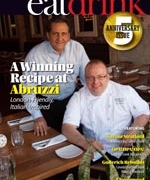Raw & Uncooked
Raw fish. I often wonder how it became such a trendy meal. We can thank the Japanese for sharing their taste for uncooked seafood and making it is easy for diners anywhere in the world to get their fix on glistening slivers of silky smooth fish pressed over rice and adorned with wasabi and pickled ginger. We can also thank Sasha Issenberg for writing about the ultimate local versus global food debate in The Sushi Economy: Globalization and the Making of a Modern Delicacy and revealing sushi’s rise to fame as a world-wide commodity.
Sushi started out in the 1800s as Japanese street food sold from shacks by ambitious chefs with dreams of earning enough money to open a real restaurant. In modern times, it has attained the status of both a fast food at all-you-can-eat sushi bar conveyor belts and a high-end delicacy at star-studded restaurants like New York’s Nobu. Sushi chefs are born from Japanese tradition with such a rigid hierarchical structure and training regimen that it could be years before an apprentice even touches a fish, let alone slices it for customers. It does seem funny that sushi chefs are held in such high esteem when, aside from cooking rice, they don’t engage in much of actual cooking of food at all – their skill comes from knife agility and the art of preparation. With knife work harkening back to samurai swordsmanship, sushi chefs become masters of their craft, creating each miniature meal as a work of art fashioned with sharp knives and deft hands. But Issenberg tells us that “the sushi chef is merely a charismatic front man for an invisible world. Behind him is a web of buyers and sellers, producers and distributors, agents, brokers, and dealers that extends from everywhere there is a net that needs to be emptied to anyplace there is a plate that can be filled.”
While diners enjoy the fruits of a chef’s labour, restaurateurs are in the thick of fish markets and fresh food auctions to get the best fish at the best price, all the while keeping their eyes on the changing patterns of supply and demand. Market pricing in this business is not something to be taken lightly because “no commodity in the world loses as much value as quickly as high-quality sushi-destined tuna.” Changes in value have increased the average price of bluefin tuna by 10,000 percent since it was first introduced to the fluctuations of economic markets three decades ago.
In an industry that relies on the freshest fish with a limited shelf life, it is remarkable that there are over 10,000 sushi restaurants in the United States alone, many of them nowhere near an ocean, and Issenberg details developments in transportation and refrigeration technology which allowed, by the mid-1970s, for tuna caught in the Atlantic Ocean on Sunday to be served fresh for lunch in Tokyo on Wednesday. Aside from the serious topics surrounding sushi, Issenberg’s book also covers a variety of quirky fish industry anecdotes from professional tuna-tossing competitions to the involvement of the Korean Moonie cult in the tuna industry in an eerily similar fashion that Columbian drug lords have over cocaine.
With freshness and cargo concerns addressed early on, the industry faces the more modern issue of the world’s fish supply dwindling at a rapid rate. Our first hope is that fish are able to replenish themselves in the wild at a rate faster than they are caught. There is also additional support in the advancement of farming Bluefin tuna, which takes away some of the risks of seafood gathering that have always been present, such as the changing of seasons, inclement weather, migratory patterns, and potentially fading natural resources. Whether ranched in Australia or hauled in from a catch off Canadian shores, whether sliced by a chef in Texas or Tokyo, Issenberg tells us that: “More than any other food, possibly more than any other commodity, to eat sushi is to display an access to advanced trade networks, of full engagement in world commerce.”











